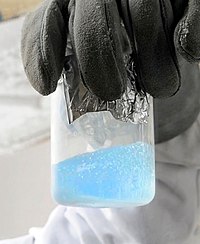
Photo from wikipedia
Organic chloramines have attracted considerable attention because of their potential toxicity and reactivity. However, the lack of suitable and effective analytical methods has limited the study of organic chloramines due… Click to show full abstract
Organic chloramines have attracted considerable attention because of their potential toxicity and reactivity. However, the lack of suitable and effective analytical methods has limited the study of organic chloramines due to their volatile and unstable properties. In this study, membrane introduction mass spectrometry (MIMS) combined with DPD/FAS titration was used to monitor the formation of organic chloramines. N-chlorodimethylamine [(CH3)2NCl] and N-chlorodiethylamine [(C2H5)2NCl] were detected and identified as the dominant volatile DBPs during chlorination of 18 organic compounds with dimethylamine or diethylamine functional groups, with yields ranging from 0.3% to 51.1% at a chlorine to precursor (Cl/P) molar ratio of 8.0. (CH3)2NBr was formed in the presence of bromide, while the formation of (CH3)2NCl was decreased. The reaction of phenol with (CH3)2NCl combined with theoretical calculations confirmed that the reactivity of (CH3)2NCl was similar to that of monochloramine. Moreover, (CH3)2NCl and (C2H5)2NCl were observed at the ppb level during chlorination of actual water samples collected from different areas. The results suggest that (CH3)2NCl and (C2H5)2NCl are important organic chloramines during chlorination, which may lead to the occurrence of further oxidation reactions and promote the formation of other disinfection byproducts simultaneously and should be of concern.
Journal Title: Water research
Year Published: 2021
Link to full text (if available)
Share on Social Media: Sign Up to like & get
recommendations!